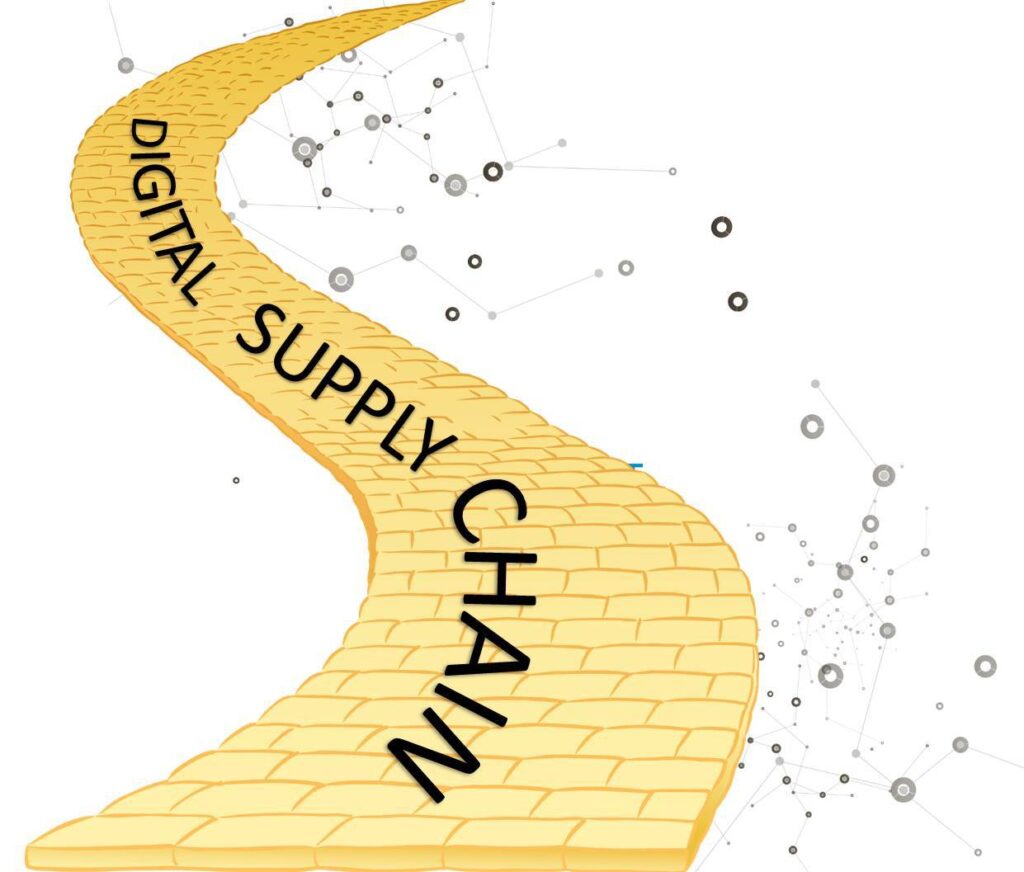In the movie the Wizard of Oz, Dorothy and her companions are told the answers they seek are found in the Emerald City. To get there, all they need to do is follow the yellow brick road. The road begins in the land of the Munchkins then heads out into forests and fields before ending at the doors of the Emerald City. Many companies seem to think there is a yellow brick road that will lead them through transformation processes directly to a digital supply chain. Admittedly the Wizard of Oz analogy is a bit forced; but, according to a study released by Deloitte and the Manufacturers Alliance for Productivity and Innovation (MAPI), most companies on the digital transformation yellow brick road remain in Munchkin Country. Patrick Burnson reports, “The study, ‘Embracing a digital future: How manufacturers can unlock the transformative benefits of digital supply networks,’ reveals a disconnect between executives’ opinions of their DSN efforts and actual implementation. … The survey of more than 200 manufacturing organizations found that 51 percent of respondents believe their DSN maturity is at least ‘above average’ compared to competitors, yet only 28 percent have started implementing DSN solutions.”[1]
Getting out of Munchkin Country
Risking the chance of taking the Land of Oz analogy a bit too far, I want to discuss how companies can get out of Munchkin Country. I liken Munchkin Country to the Industrial Age and compare Dorothy and her companions to companies organized around Industrial Age principles. Their goal is to follow the yellow brick road through digital transformation and become digital enterprises leveraging digital supply chains. Lest there is any doubt about this being the Digital Age, Kaushal Dave (@KDplan), vice president of cognitive solutions at Aera Technology, writes, “The modern global supply chain is defined by scale — billions of transactions and terabytes of data across multiple systems, with businesses generating more every moment. Traditional supply chain management (SCM) practices are quickly being outmatched by the ceaseless onslaught of information.”[2]
Dorothy and her companions had to make the journey to the Emerald City one step at a time. Companies need to take that same approach in their journey to transform into digital enterprises with digital supply chains. Dave recommends three steps that will help get companies out of Munchkin Country. They are:
Step 1: Choose a project. “For a first project,” Dave writes, “it’s best to identify a specific supply chain issue that could be solved with AI. That helps focus efforts and resources on a single problem, rather than throwing spaghetti at the wall. Naturally, you’ll want to select a significant pain point with implications for your supply chain efficiency, customer satisfaction, and bottom line.”
Step 2: Prepare the data. “Data is a critical ingredient of AI readiness. Ideally, companies apply AI to large data sets of deep granularity — for instance, three years of data with granularity down to the daily transactional level by SKU locations, orders, plants, raw materials, customers, and more. Because you may draw data from different systems — ERP, MRP, CRM, and others — you ideally have time frame consistency across those data sets. In other words, if you have six months of raw materials data, one year of inventory data, and three years of sales data, AI can become problematic.”
Step 3: Find the right technology partner. “For companies that decide supply chain AI is right for them (which can depend on scale, complexity, etc.), success depends heavily on the technology partners they choose and the services those providers offer. Because AI is still an emerging innovation, it’s essential to ensure the technology partner you choose is equipped to work with you through obstacles and devise solutions that address your needs.”
I agree with those steps. At Enterra Solutions® we recommend a “crawl, walk, run” approach to solution implementation. This approach allows experimentation and refinement before full-scale implementation of the solution. Our artificial intelligence solutions leverage the Enterra Artificial Intelligence Learning Agent™ (AILA®) — a system that can Sense, Think, Act, and Learn®.
What does the supply chain look like in the Emerald City
Getting out of Munchkin Country isn’t the goal. The objective is to implement a digital supply chain. What might that look like? Marcell Vollmer (@mvollmer1), Chief Digital Officer and Senior Vice President for SAP Ariba, describes four achievable end states of a digital supply chain.[3] They are:
1. A smarter supply chain. By leveraging cognitive technologies in an Internet of Things ecosystem, supply chains can become much smarter. Vollmer explains, “Once installed, the machine can use Big Data algorithms to learn patterns and behaviors. This approach enables them to detect the threat of malfunctions that require maintenance, define factors impacting performance and optimize processes and opportunities for automation.”
2. Profitability with unprecedented optimization and simplification. Vollmer writes, “The struggle against complexity is something that plagues the mind of supply chain managers. From a growing network of suppliers and the risk of corrupt sourcing practices to trade restrictions and just-in-time delivery, automation can help them sleep better at night. The Center for Global Enterprise research has revealed that the more digital the supply chain, the greater the chance the business can reduce procurement costs by 20%, lower supply chain process costs by 50% and increase revenue by 10%.”
3. Increased employee productivity. “The use of robots in the supply chain is a hot topic. But contrary to widespread fears, the real news is not about eliminating human jobs — it’s about making work more meaningful and challenging for everyone while offsetting a looming labor shortage. In fact, IDC predicted that 50% of fulfillment centers will have co-bots operating next to humans in the picking, packing and shipping floor to drive up productivity up 30% and lower the cost of operations.”
4. Value-added supply chains. “Supply chain management should prepare for the future by implementing the IoT and defining new use cases to tap into never-before-conceived revenue streams.”
Dorothy and her companions didn’t find travelling the yellow brick road to be an easy journey (that wouldn’t have made for much of a story). Along their way they had to deal with challenges like witches, soldiers, and flying monkeys. Companies will also find challenges on their journey towards a digital supply chain. The editorial staff at Material Handling & Logistics report a study released by Janeiro Digital found those challenges include cultural challenges.[4] “These cultural obstacles came to the surface when respondents were asked about challenges their organization encountered when looking to implement new technologies.” They include:
- A lack of enthusiasm or support for change was directly cited by 23.5% of respondents.
- Unrealistic budgets (27.6%) were another prominent issue cited, which points to the lack of appetite for change and even a reluctance to put resources behind it.
- Only 4.1% of survey respondents felt strongly that their existing technology deployments are holding them back from new innovations. A whopping 67.4% don’t see their current technology deployments as an issue.
Just like Dorothy and her companions had to wake up after falling asleep in a field of poppies in order to continue their journey, companies need to wake up to the fact they might not be as far along the road to digital transformation as they might think.
Summary
The editorial staff at Material Handling & Logistics note, “When it comes to digital maturity, the supply chain and logistics industry are lagging.” Stephen Laaper, a principal at Deloitte Consulting, adds, “While enthusiasm is high and manufacturers realize the benefits of Digital Supply Networks, many companies struggle to identify the right technology landscape which will provide the most value when they are approaching a digital shift. As a result, many hold off with key aspects of their transformation, which in turn puts their transformation at too slow a pace to avoid disruption.”[5] It’s time to pick up the pace and get out Munchkin Country, because in real life there are no ruby slippers that will magically take you where you need to go.
Footnotes
[1] Patrick Burnson, “Digital supply chain expectations outpace reality, says new study,” Supply Chain Management Review, 10 April 2018.
[2] Kaushal Dave, “3 steps to getting started with supply chain AI,” Venture Beat, 25 March 2018.
[3] Marcell Vollmer, “Artificial Intelligence: What’s Now and Next in IoT-Driven Supply Chain Innovation,” Outsource, 24 March 2018.
[4] Staff, “Roadblocks Preventing Digital Transformation in the Supply Chain,” Material Handling & Logistics, 2 may 2018.
[5] Burnson, op. cit.





